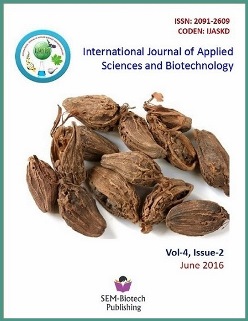Parasitic Infections among Children of Squatter Community in Dharan Municipality, Sunsari, Nepal
DOI:
https://doi.org/10.3126/ijasbt.v4i2.15099Keywords:
Children, Parasitic infection, Prevalence, Dharan Municipality, Squatter CommunityAbstract
Background and Objective: Children of squatter community are more prone to many infections and epidemiological studies provide to develop suitable preventive plans. Thus, the main objective of the present study was to determine the prevalence of parasitic infections among children of Squatter Community of Dharan Municipality.
Methodology: Altogether 184 stool samples were collected from June 2014 to January 2015. The samples were examined using direct microscopy by saline wet mount technique in the microbiology laboratory of Sunsari Technical College, Dharan.
Results: The overall prevalence of intestinal parasites was found to be 41.4% with male children more infected (45.8%) than female children (37.5%). Children between 4-8 years of age were most infected (48.1%). Among 4 species of parasites detected Ascaris lumbricoides (18.1%) was the commonest helminths and Giardia lamblia (74.02%) was the commonest protozoa. Positive rate was higher in Dalits (59.7%, 43/72) and the least in Tibeto-Burman (27.1%, 22/81) (p<0.05) ethnic groups.52.5% of children not using water and 33.6% of children using bucket water at toilet after defecation were infected. Children using soap for hand washing after defecation were less infected (32.02%) than other children (55.1%). Children taking the anti-parasitic drug in last six months had significantly low positive rate (9.3%) than others (51.7%) (p<0.05).
Conclusion: High prevalence of parasitic infection was observed among children in Squatter community of Dharan Municipality. Thus, health education along with infection management actions and the awareness programs for sanitation improvements are required to reduce the parasitosis.
Int J Appl Sci Biotechnol, Vol 4(2): 203-206




